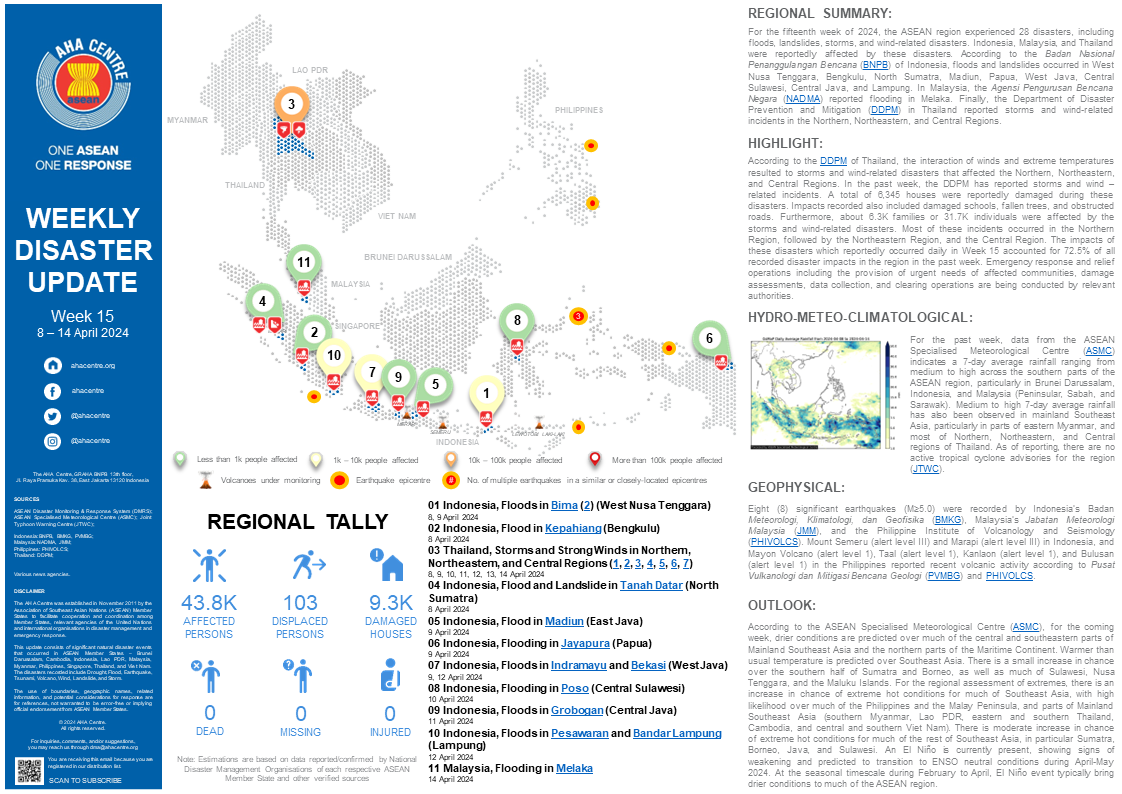
REGIONAL SUMMARY:
For the fifteenth week of 2024, the ASEAN region experienced 28 disasters, including floods, landslides, storms, and wind-related disasters. Indonesia, Malaysia, and Thailand were reportedly affected by these disasters. According to the Badan Nasional Penanggulangan Bencana (BNPB) of Indonesia, floods and landslides occurred in West Nusa Tenggara, Bengkulu, North Sumatra, Madiun, Papua, West Java, Central Sulawesi, Central Java, and Lampung. In Malaysia, the Agensi Pengurusan Bencana Negara (NADMA) reported flooding in Melaka. Finally, the Department of Disaster Prevention and Mitigation (DDPM) in Thailand reported storms and wind-related incidents in the Northern, Northeastern, and Central Regions.
HIGHLIGHT:
According to the DDPM of Thailand, the interaction of winds and extreme temperatures resulted to storms and wind-related disasters that affected the Northern, Northeastern, and Central Regions. In the past week, the DDPM has reported storms and wind –related incidents. A total of 6,345 houses were reportedly damaged during these disasters. Impacts recorded also included damaged schools, fallen trees, and obstructed roads. Furthermore, about 6.3K families or 31.7K individuals were affected by the storms and wind-related disasters. Most of these incidents occurred in the Northern Region, followed by the Northeastern Region, and the Central Region. The impacts of these disasters which reportedly occurred daily in Week 15 accounted for 72.5% of all recorded disaster impacts in the region in the past week. Emergency response and relief operations including the provision of urgent needs of affected communities, damage assessments, data collection, and clearing operations are being conducted by relevant authorities.
HYDRO-METEO-CLIMATOLOGICAL:
For the past week, data from the ASEAN Specialised Meteorological Centre (ASMC) indicates a 7-day average rainfall ranging from medium to high across the southern parts of the ASEAN region, particularly in Brunei Darussalam, Indonesia, and Malaysia (Peninsular, Sabah, and Sarawak). Medium to high 7-day average rainfall has also been observed in mainland Southeast Asia, particularly in parts of eastern Myanmar, and most of Northern, Northeastern, and Central regions of Thailand. As of reporting, there are no active tropical cyclone advisories for the region (JTWC).
GEOPHYSICAL:
Eight (8) significant earthquakes (M>5.0) were recorded by Indonesia’s Badan Meteorologi, Klimatologi, dan Geofisika (BMKG), Malaysia’s Jabatan Meteorologi Malaysia (JMM), and the Philippine Institute of Volcanology and Seismology (PHIVOLCS). Mount Semeru (alert level III) and Marapi (alert level III) in Indonesia, and Mayon Volcano (alert level 1), Taal (alert level 1), Kanlaon (alert level 1), and Bulusan (alert level 1) in the Philippines reported recent volcanic activity according to Pusat Vulkanologi dan Mitigasi Bencana Geologi (PVMBG) and PHIVOLCS.
OUTLOOK:
According to the ASEAN Specialised Meteorological Centre (ASMC), for the coming week, drier conditions are predicted over much of the central and southeastern parts of Mainland Southeast Asia and the northern parts of the Maritime Continent. Warmer than usual temperature is predicted over Southeast Asia. There is a small increase in chance over the southern half of Sumatra and Borneo, as well as much of Sulawesi, Nusa Tenggara, and the Maluku Islands. For the regional assessment of extremes, there is an increase in chance of extreme hot conditions for much of Southeast Asia, with high likelihood over much of the Philippines and the Malay Peninsula, and parts of Mainland Southeast Asia (southern Myanmar, Lao PDR, eastern and southern Thailand, Cambodia, and central and southern Viet Nam). There is moderate increase in chance of extreme hot conditions for much of the rest of Southeast Asia, in particular Sumatra, Borneo, Java, and Sulawesi. An El Niño is currently present, showing signs of weakening and predicted to transition to ENSO neutral conditions during April-May 2024. At the seasonal timescale during February to April, El Niño event typically bring drier conditions to much of the ASEAN region.
Sources:
ASEAN Disaster Monitoring & Response System (DMRS); ASEAN Specialised Meteorological Centre (ASMC); Joint Typhoon Warning Centre (JTWC);
Indonesia: BNPB, BMKG, PVMBG;
Malaysia: NADMA, JMM;
Philippines: PHIVOLCS;
Thailand: DDPM;
Various news agencies.







